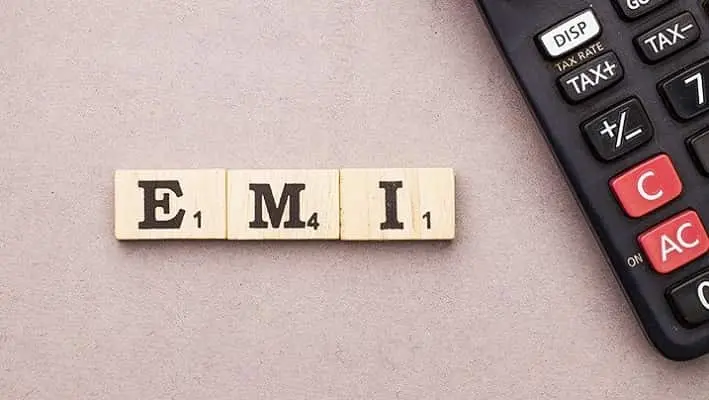A facility known as Equated Monthly Instalment, EMI is one that a borrower offers to a creditor. The creditor is required to make a set monthly payment every month. Both principle and interest amounts are covered. The loan expires once the EML is finished. You can purchase anything on EMI, including a cell phone, smart TV, appliances, an apartment, a car, etc. The facility makes it easier to repay a loan in installments rather than all at once. Despite having obvious advantages and being promoted by financial institutions, EMIs are still largely unknown.
This page offers a thorough explanation of everything there is to know about EMI, including both its advantages and disadvantages. The term “full EMI” describes payments that include both the principal and interest. Pre-EMI, on the contrary hand, refers to paying only the interest. The borrower has the option to pay only the interest portion of the loan at the time of disbursement in order to avoid starting the repayment period. Pre-EMI payments are not taken into account when calculating loan tenure because they are made before payback.
What Is The EMI’s Process?
It is a particular type of payment agreement between the lender and the borrower. Borrowers receive one set of installments per month under the EMI arrangement. Since the amount is predetermined, borrowers are aware of what they must pay. It facilitates their financial planning. In contrast hand, the lender receives a regular payback plus interest.
Factors that have an impact on interest rates and EMI
The following are the primary EMI-influencing factors:
Principal Amount
- The principal Amount in the EMI is directly related to the primary amount and is based on it. Therefore, the EMI will be greater the higher the principal.
The interest rate
- The amount that banks or other non-banking financial firms charge for a loan is known as the interest rate. A number of variables, including the borrower’s credit history and profile, affect the rate.
Advantages of EMI
Here are benefits of EMI:
- Freedom to Purchase Expensive Utilities: EMI allows consumers the opportunity to purchase expensive utilities that they would not otherwise be able to. EMI enables you to purchase everything and anything, including pricey furniture, a car, wedding gifts and jewelry, and a home. Customers buy the product and take advantage of the advantages since they have the option to divide the cost into manageable monthly installments. This benefits merchants and traders as well as customers who purchase such expensive utilities. EMIs are similar to a wishbone for the average person.
- Easy on the wallet: The borrower can choose the EMI plan to pay back the loan in regular monthly installments. The sum is established based on the principal loan amount, loan length, interest rate, and borrower’s repayment capacity. This makes it simpler for lenders to make monthly payments of the specified amount. They can therefore afford a variety of pricey utilities without having to cut back on their monthly spending.
- Banks’ Flexible EMI Options: Today, many banks give borrowers flexible EMI choices. The EMIs are changed and chosen based on the borrower’s needs. The borrower chooses the installment and term based on what is most convenient for them.
Disadvantages of EMI
Here are some drawbacks of EMI:
- Extended Debts: The borrowers must make monthly payments, or EMIs, until the principal balance and the appropriate interest rate have been satisfied. These periods might be as long as twenty to thirty years for personal or house loans. Therefore, a borrower must pay back loan installments for almost half of either his or her lifetime. This prevents the borrower from acquiring any other similarly opulent utilities in the near future.
- No Early Repayment: Banks do not provide a simple option for borrowers who seek to repay a loan earlier than planned using additional savings or a bonus. Such debtors are subject to early repayment costs from many banks and NBFCs. Even if they could, this makes it challenging for the debtors to repay the loan earlier.
- Charges for Skipping EMIs: Banks and NBFCs impose late fees on borrowers who forget to pay an EMI on or before the due date. Banks & NBFCs have stringent rules regarding EMI repayment. Multiple missed EMIs may result in legal action being taken against the borrower, or the bank may confiscate the collateral.
- Additional Charges: The borrower is required to pay interest on top of the actual amount borrowed. The borrower is obligated to pay this extra sum since the principal balance and interest rate are added together to create an EMI.
Also Read: Why Bajaj EMI Card Transaction Got Declined By the Bank?
Conclusion
EMI offers benefits and drawbacks for customers, as we discovered in the article above. Although EMI is easy on the customer’s wallet and produces a smooth payment, it will consistently result in greater payment. When determining your ability to repay a loan, it is always important to study the tiny print of the agreement and use an online EMI calculator.
EMI Frequently Asked Questions
Q1: What types of purchases can be made through EMI?
Ans: EMI can be used for various purposes, such as purchasing consumer goods like electronics, appliances, furniture, etc., or for financing loans like home loans, car loans, personal loans, etc.
Q2: How is EMI calculated?
Ans: EMI calculation depends on the loan amount, interest rate, and the loan tenure. It is calculated using mathematical formulas that consider these factors. Different lenders may have variations in their EMI calculation methods.
Q3: Can I prepay my EMI before the completion of the tenure?
Ans: Yes, you can choose to prepay your EMI before the completion of the tenure. However, there might be certain terms and conditions or prepayment charges associated with it. It is advisable to check with your lender regarding their policies on prepayment.
Q4: What happens if I miss an EMI payment?
Ans: If you miss an EMI payment, the lender may charge a late payment fee or penalty. It can also affect your credit score and future borrowing capabilities. It is important to make timely payments to avoid any negative consequences.
Q5: Can I change the EMI amount or tenure after taking the loan?
Ans: Generally, it is not possible to change the EMI amount or tenure once the loan has been disbursed. However, some lenders may allow you to modify the EMI structure under certain circumstances. It is best to check with your lender regarding their policies.
Q6: Is it better to opt for a longer tenure or a shorter one?
Ans: The choice of tenure depends on your financial situation and repayment capacity. A longer tenure may result in smaller EMIs but higher overall interest payments. On the other hand, a shorter tenure will have higher EMIs but lower interest payments. Assess your affordability before deciding on the tenure.
Q7: Are there any additional charges apart from the EMI?
Ans: Yes, there might be additional charges associated with the loan or EMI, such as processing fees, prepayment charges, foreclosure charges, late payment fees, etc. It is important to carefully review the terms and conditions provided by the lender to understand all the associated charges.















